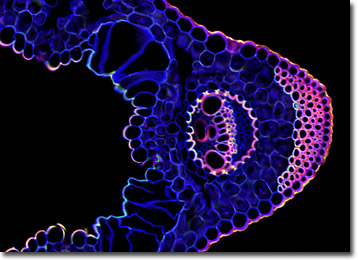 |
 |
 |
|
||||||||||||||||||||||||
 | ||||||||||||||||||||||||
 | ||||||||||||||||||||||||
 | ||||||||||||||||||||||||
Confocal Microscopy Image Gallery
Plant Tissue Autofluorescence Gallery
Grass Leaf
Commonly grass is thought of as the short, green ground cover of lawns, but a wide variety of monocotyledonous flowering plants comprising the family Poaceae (sometimes alternatively termed Gramineae) are grasses. Nearly 10,000 species are classified in the grass family, including many economically important plants, such as corn, wheat, barley, rice, rye, sugarcane, and bamboo.

Cereal grasses have been cultivated since about 8000 BC, and today the majority of farmland around the world is dedicated to their propagation. Much of the rest of the Earth is naturally covered by grasses, which grow rapidly and are well adapted for survival. Though most plants exhibit growing points at the tips of their stems, grasses possess basal meristems so that even when the upper section of a grass is lost due to grazing, fire, or cutting, regrowth may easily occur.
The leaves of grasses vary somewhat in size, shape, and texture, but generally are elongate or elliptical and exhibit parallel veins. Three basic components comprise each leaf of a grass, the sheath, blade, and ligule. Leaf sheaths arise at nodes and encircle the stem, contributing to the structural support of the plant. The blade is the green part of the grass leaf that is the site of photosynthesis. Blades are typically flat, but in some grass species they curl into a thin, tube-like shape in order to reduce surface area and loss of water from the plant. A small, strap-like structure located at the junction between each leaf sheath and blade is known as the ligule. The function of the ligule is not known for certain, but it is considered by some to have evolved as a means to thwart water molecules from invading the sheath.
Contributing Authors
Nathan S. Claxton, Shannon H. Neaves, and Michael W. Davidson - National High Magnetic Field Laboratory, 1800 East Paul Dirac Dr., The Florida State University, Tallahassee, Florida, 32310.
